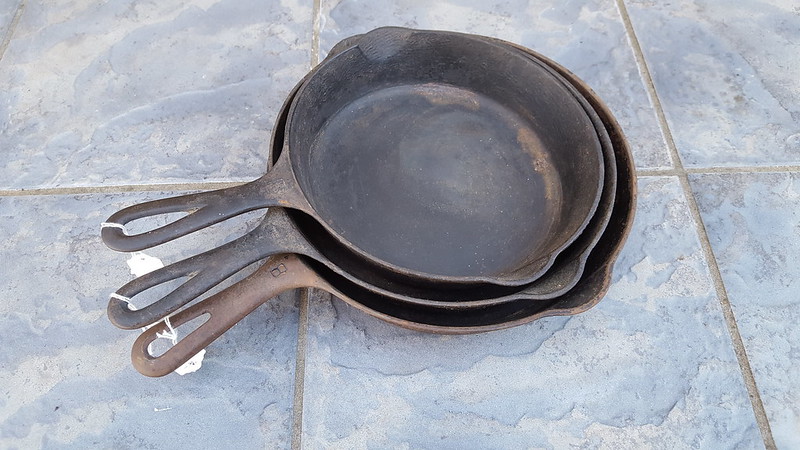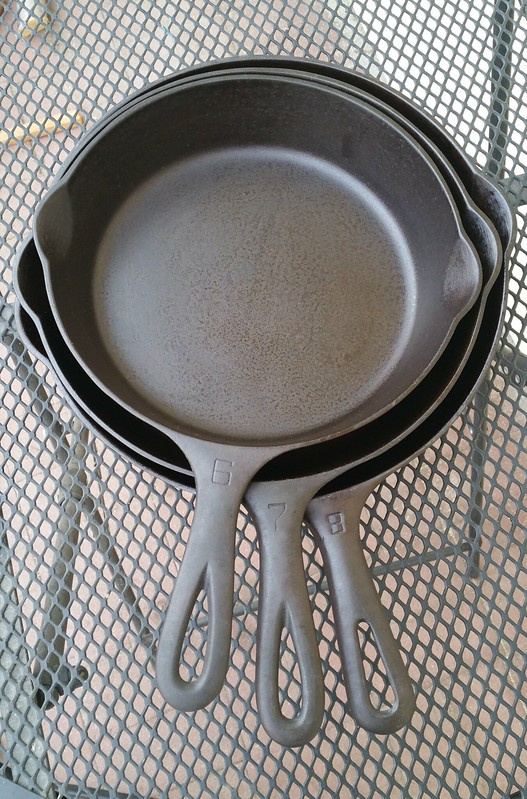Christian James
Member
From my admittedly limited research, I've learned that there are five ways people use to clean and restore vintage cast iron.
1) Scrub the pans until your arms fall off.
2) EZ Off and a bit of elbow grease.
3) Lye bath.
4) Electrolysis tank.
5) Fire/self-cleaning oven cycle.
I bought three pans last week that were in need of serious cleaning. The interiors didn't look too bad, but the exteriors were disgusting. Either way I was going to strip them because there is no way I am going to use pans of unknown history without a thorough cleanse.

For various reasons, the methods above don't work for me. I have a young family, I have better things to do with my time than spend a weekend scrubbing. EZ Off could work, but I'd rather avoid dealing with the chemicals in the stuff. That rules out the lye bath as well.
I know the electrolysis tank is the preferred way of cleaning old CI, but it's not worth the hassle. I'm no collector and have no intentions of becoming one, so building a tank for three pans is overkill.
Then there is the fire/self-cleaning oven cycle. There is a lot of disagreement on this, with many endorsing this technique as a great way to cleaning old pans. While those who hold this opinion may have long years in cooking and using CI, they seem to have less experience in restoration and only deal with a few items. The ones who handle lots of cast iron, both the professionals and the passionate collectors insist that this method needlessly subjects vintage cast iron to damage. The high temperatures involved (800-900 °F) can cause significant warpage. Then there are the potential problems involved in using your oven's self-cleaning feature. I've read of people blowing fuses or their oven's control panel. That sounds like a very expensive fix and not worth the headache just so I can clean a few bucks worth of metal.
So what to do?
I remembered a couple of years ago when I was cooking a steak, I forgot to take out the Lodge that lives in my oven prior to preheating. The pan was none the worse for wear, but the seasoning was destroyed. I figured if this process took off seasoning accidentally, it should be able to do it deliberately.
So I set the oven to its highest baking setting (550 °F). I immediately placed the pans in the oven so they could warm up with oven. I don't know if it's necessary, but what could it hurt? Once they reached the desired temperature, I left them there for two hours and turned the oven off. Once everything had cooled, I took the pans out.
The old seasoning and crud was finished. It was powdery in some places, flaky in others. A bit of coaxing with a grill brush (maybe 10-15 minutes each) had the pans down to bare metal. I quickly placed the pans in a vinegar and water solution to get rid of the rust, and fired up the oven again so I could start seasoning them.
Here are the results. Three beautiful SBL Griswolds, in sizes 6, 7, and 8.

What do you think? Is this a viable cleaning alternative? Or is 550 °F still too hot and potentially damaging to the old black stuff?
1) Scrub the pans until your arms fall off.
2) EZ Off and a bit of elbow grease.
3) Lye bath.
4) Electrolysis tank.
5) Fire/self-cleaning oven cycle.
I bought three pans last week that were in need of serious cleaning. The interiors didn't look too bad, but the exteriors were disgusting. Either way I was going to strip them because there is no way I am going to use pans of unknown history without a thorough cleanse.

For various reasons, the methods above don't work for me. I have a young family, I have better things to do with my time than spend a weekend scrubbing. EZ Off could work, but I'd rather avoid dealing with the chemicals in the stuff. That rules out the lye bath as well.
I know the electrolysis tank is the preferred way of cleaning old CI, but it's not worth the hassle. I'm no collector and have no intentions of becoming one, so building a tank for three pans is overkill.
Then there is the fire/self-cleaning oven cycle. There is a lot of disagreement on this, with many endorsing this technique as a great way to cleaning old pans. While those who hold this opinion may have long years in cooking and using CI, they seem to have less experience in restoration and only deal with a few items. The ones who handle lots of cast iron, both the professionals and the passionate collectors insist that this method needlessly subjects vintage cast iron to damage. The high temperatures involved (800-900 °F) can cause significant warpage. Then there are the potential problems involved in using your oven's self-cleaning feature. I've read of people blowing fuses or their oven's control panel. That sounds like a very expensive fix and not worth the headache just so I can clean a few bucks worth of metal.
So what to do?
I remembered a couple of years ago when I was cooking a steak, I forgot to take out the Lodge that lives in my oven prior to preheating. The pan was none the worse for wear, but the seasoning was destroyed. I figured if this process took off seasoning accidentally, it should be able to do it deliberately.
So I set the oven to its highest baking setting (550 °F). I immediately placed the pans in the oven so they could warm up with oven. I don't know if it's necessary, but what could it hurt? Once they reached the desired temperature, I left them there for two hours and turned the oven off. Once everything had cooled, I took the pans out.
The old seasoning and crud was finished. It was powdery in some places, flaky in others. A bit of coaxing with a grill brush (maybe 10-15 minutes each) had the pans down to bare metal. I quickly placed the pans in a vinegar and water solution to get rid of the rust, and fired up the oven again so I could start seasoning them.
Here are the results. Three beautiful SBL Griswolds, in sizes 6, 7, and 8.

What do you think? Is this a viable cleaning alternative? Or is 550 °F still too hot and potentially damaging to the old black stuff?
